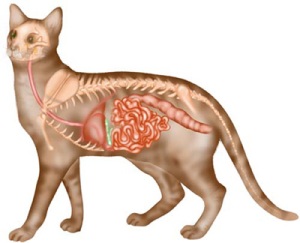The history of cat food has primarily been founded on looking out for the convenience of the cat’s caretaker. But in this day and age, people are beginning to realize that with things such as refrigerators and freezers, that we CAN easily make a shift from canned and dry cat food back to their natural diet. Cat’s are considered obligate carnivores, meaning that they are made to eat meat and only meat. Here are a few facts that emphasize this point:
- Their digestive system is only 4x their body length (compared to 6x in dogs). The more carnivorous an animal is, the shorter its digestive tract is relative to its body length; for example a sheep’s digestive tract is 27 times its body length
- Relatively small stomachs with a very low pH make it acidic enough to destroy bacteria such as Salmonella and other food borne bacteria.
- Require smaller meals numerous times a day due to their fast digestive transit time of 12 to 14 hours (12 hours to 57 hours for dogs).
- Cannot produce the enzyme amylase from their salivary glands or from their pancreas. Amylase is an enzyme produces by omnivores or herbivores that digests starch found in grains and other plant products..
- A cat’s skull has sharp carnivorous teeth with few molars making them excellent predators for shearing and tearing prey.
- Cats cannot taste sweetness.
- Metabolism control is mostly due to protein intake since their pancreas uses amino acid (from protein) triggers for insulin release, not glucose as with people and dogs.
At Barker’s Dog Club, we sell formulated raw food for cats in convenient portion sizes (4 oz patties) and you will definitely see some great improvements in the health of your cat on raw food. A shinier, more vibrant coat, more energy, clear eyes and ears, clean teeth and firm stools are signs to look for that an appropriate carnivorous diet for your cat is doing its job!



You must be logged in to post a comment.